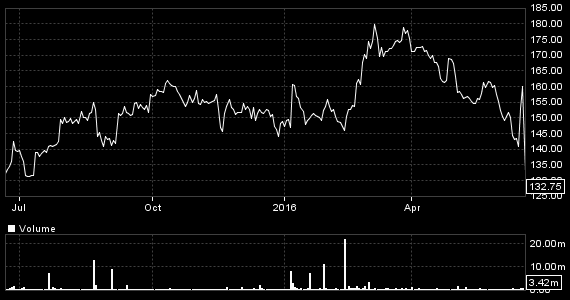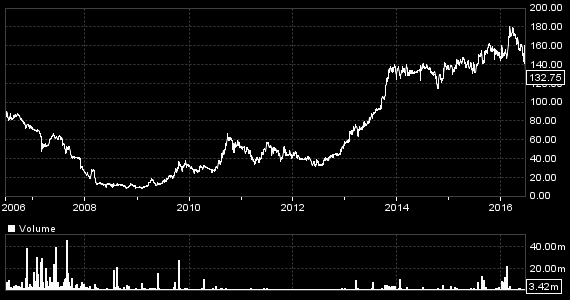Photo-Me: Has the Sell-Off Been Overdone?

Photo-Me International (PHTM) has just announced the dividend increase for 2016 that investors had been expecting, with an 87% jump in the total (paying 6.1p to holders before October 6th, after 9.1p for the full year) including the second special dividend in two years (although it was a little less than some had forecast) on the back of strong growth in its overseas operations and the benefits of a promising new business.
Yet, despite a bullish outlook and after a brief blip in anticipation yesterday, the shares immediately relapsed back to their steady downward trend, in place since February, which seems to have been due to a number of large share stakes being sold or switched.

Was that because those holders (who included long-term investor Schroders and the offshore vehicle of one of PHTM’s founders) see some operational problem, or are they just nervous following the near-disaster in 2007/8 when the decline in film photography – and Kodak’s demise – caught short Photo-Me’s expensive expansion into mini-labs – or might it just reflect their own strategies? Judging by the way the shares were marked down sharply on opening today, maybe they haven’t finished. So when they have done, will PHTM be worth buying?
Despite a long history and a well known name, Photo-Me has never been particularly well followed by brokers. So its business profile and operating characteristics are not as well understood as they might be. Although UK investors tend to know it through its estate here of 6,600 traditional photo-booths (and its lesser known kiddie-rides) most (and the only really growing part) of the company’s business is in France and Japan where some 72% of all its vending machines of all types are situated and which tend to be more technologically advanced than in the UK. In addition, its business in those markets stands to benefit at present from recent government requirements for the advanced photo-identity cards, and bio and 3D recognition technology that the company has been developing.
The latest results (before adjusting for exchange rates) showed this, with profits in Asia (before UK central costs) ahead by 55% (to account for 25% of the group) on a 16% rise in turnover, and profit in Continental Europe (mainly France, but also Germany, Switzerland, and Belgium) ahead by 15% (to account for 57% of the group). But maybe the share mark-down was because growth in Japan was in practice slower than originally expected, as the government’s roll-out, starting this year, of its new identity system ran into teething problems. With these being addressed, however, it doesn’t seem enough to account for the poor response by the shares.
It is not just in these photo-identity systems that PHTM expects further growth, because for three years it has been capitalising on its network to roll out and trial a new concept in self-service ‘Revolution’ laundry units in locations such as supermarkets, student accommodation and camp-sites. Mainly located so far in France, Portugal, and Ireland these now total 1,411 (with a target for 6,000 by 2020) and accounted for 6.4% of group revenue with higher than average profitability. They are manufactured for the company in Hungary with about half again sold to other operators, so are likely to be equally profitable.
It was partly because Photo-Me used to manufacture its own equipment in France that it ran into problems in the mid 2000s, and so more recently has been outsourcing to other manufacturers in Eastern Europe and China. But it is also why investors need to be aware of its business model, by which a high charge for depreciation – which can make the bottom line profit sensitive to relatively small movements in gross profit while masking the company’s high level of cash generation – can either be devoted to paying dividends or has to be ploughed back into developing and updating its equipment.

The wild swings in available cash that this structure can cause if revenues and margins come under pressure was another feature of the disaster that affected Photo-Me in 2007/8, leading to drastic changes in management and a major restructuring, all of which is now hopefully in the past.
However, despite (or because of) Photo-Me’s stated strategy – “to use the significant cash flow from the long-established photo booth business to develop new and complementary products to drive future growth” – the danger is that the cash it ploughs back into development might be wasted, as it was in its (technically excellent) mini-labs, which faced a severe drop in their market, together with a few other forays into gadgets that didn’t work so well. Memories of the latter might be looming large in the minds of some of those investors recently selling.
Not necessarily though, because on the surface the company seems very confident – enough so at least for it to promise to increase the ordinary dividend (currently yielding 4.2%) by 20% in each of the next two years. In addition, it has promised to pay as a special dividend the excess of cash in its balance sheet over £50m “provided that the business has no immediate needs for the capital, for example for acquisitions or specific investments”. (There was £60.2m free cash on the end March balance sheet – hence that £10.6m special dividend).
This is obviously possible because the company is now in a phase where cash generation is exceeding depreciation and the needed capital investment: “Our cash generation remained strong and we improved our net cash balance to £62.4 million despite investments and dividend payments totalling £43.4 million during the year.” And as for the outlook: “Whilst uncertainties remain, in particular in relation to currency, the Board anticipates another year of good growth.”
So what is the case for an investment in the shares? Obviously the dividend outlook is attractive, and, for the moment, the new business in prospect in Japan and France and for the laundromats looks like producing useful growth in the next few years.
The PER, though, at 18.2 times is relatively high (i.e. the generous dividend isn’t very well covered) for what some may regard as a company with the risk that its products may not perform beyond a possibly short-lived surge in demand for its photo-identity products which depends on government initiatives. (Incidentally, in Japan and France these initiatives have taken a long time coming to fruition since Photo-Me first became enthusiastic about them.)
And as for those share sales, Schroders still has 13% of its original 20% – and we don’t know if it is still selling.
However, maybe we will see the start of a recovery, with some large buys appearing mid-day after the relentless drip-drip of relatively small sales since February and on opening after the results. That said, I don’t think Photo-Me has the longer term attractions of many of the mining stocks that I have put forward, especially in this phase of the market where gold seems bent on maintaining its current upward momentum. Some readers might think Photo-Me is less risky than those, however! It is always Horses for Courses.
Comments (0)